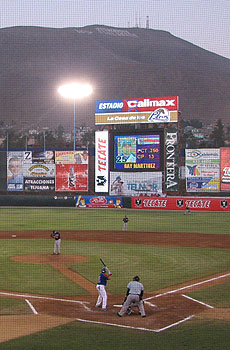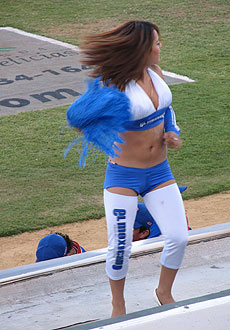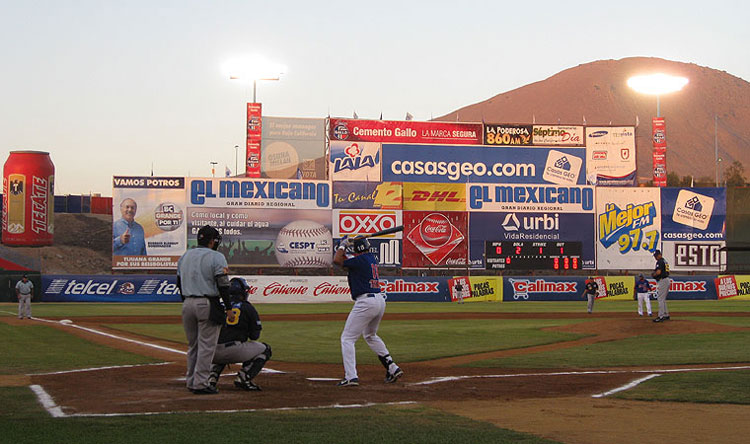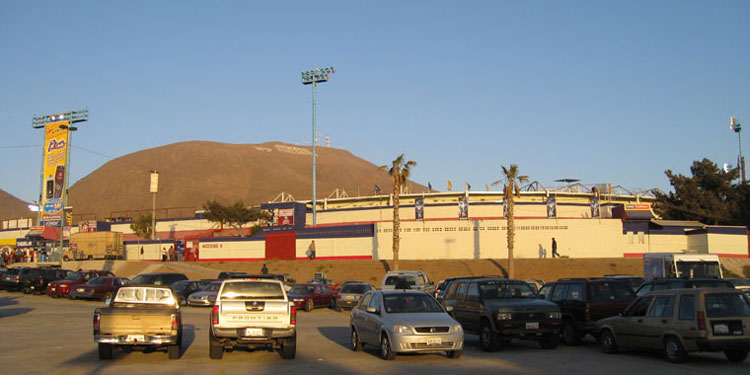
|
Many a fond memory of America's national pastime are born on warm summer evenings and ideal conditions would reveal a cloudless sky eventually yielding way to a full moon as night falls. On the rare occurrence that such weather and conditions exist, there's no place better to be than a ballpark. So I just had to be at a ballgame on such an occasion.
With first pitch temperature around 70 degrees and the sky a pure hue of blue - the full moon was still an hour away from making its appearance - I was taking advantage of a perfect night for baseball. It's too bad, I thought, that most of the city's 1.5 million residents we're missing out. As for having a $60.00 seat behind home plate - one with a spectacular view of the mountains just beyond the outfield fence - well, that was just a nice bonus. But it's not quite what you think. Baseball in an international setting never is, after all. The Mexican city of Tijuana is known for a lot of things, but béisbol isn't one of them. So it would be fair to say that two friends and I were the only Americans to cross the US-Mexico border on the evening of Thursday June 28, 2007 for the sole purpose of watching baseball. Our destination was Estadio Calimax, a 15-20 minute cab ride from the Otay Mesa border crossing, and home of the Potros de Tijuana of the aptly titled Mexican League. Named after a supermarket chain, Calimax Stadium is nestled between the red hills and homes of the Cerro Colorado neighborhood, which has served as the host for the 12,000-seat ballpark since it was built in 1976. Interestingly, Tijuana's Estadio Calimax is so close to San Diego's Petco Park that it would encroach upon the Padres territorial rights if it weren't for the border. And although the two ballparks are only about 25 miles apart, the experience of seeing a game in each is as different as the cities themselves. Which is to say worlds apart. For starters, the tickets in Tijuana are priced in pesos. The American dollar is ten times stronger than the peso, so the $60.00 price listed on the Potros paper ticket stub doesn't convert into a lot of money spent. In reality, it costs just $6 US dollars to buy the best seat in the stadium. Although the game on the field is pretty much the same as in the States, its presentation is anything but the norm. The ceremonial first pitch isn't thrown out until after the 5th inning and the 7th inning comes and goes without the traditional stretch. Music at a Mexican League game is a constant. Almost instantly after the ball lands in the catcher's mitt a song is blaring over the stadium’s loudspeakers. We're used to the theme songs that accompany hitters to the plate nowadays, but a lot more than the snippet of a song is played for them in Mexico. For example, Luke Allen strode to the plate to "Lose Yourself" by Eminem. If Allen, who briefly played for the Dodgers and Rockies, had a long at-bat fans would get to hear most of Eminem's song, including all the expletives, in between pitches. The music whips the crowd into a frenzy, which is the point, and Estadio Calimax has a very lively atmosphere as a result. The Potros mascot even stays on the field, in foul territory, leading cheers during the game
During normal breaks in the action, like between pitches, the scoreboard frequently focuses its attention on regular fans in the stands, and I think fans come to the games as much to watch themselves as the players on the field. The scoreboard also does its part to prompt fans to make more noise, and they always oblige. The vivid colors throughout the ballpark add to the festive atmosphere and the Potros multi-colored uniforms bring back fond memories of the jerseys Major League teams wore in the 80s. Vendors flood the stands so you don't have to get up from your seat to buy food or drink, but if you do there's a large concourse that caters to every type of palette you can imagine. There's even a restaurant atop the first base grandstand - no doubt inspired by the modern American ballpark - where fans dine, drink and watch the game. Everything is sponsored, and that includes the uniforms of the players (Tecate beer) and dancing girls (El Mexicano newspaper). Sponsor logos are emblazoned on the field, going so far as completely filling the first and third base coaching boxes. Large inflatable Coke and Tecate cans stand next to each foul pole. The outfield walls are covered in advertising just like US minor league ballparks, which is fitting since the 16-team Mexican League, classified as Tripe-A baseball, is the only international league officially recognized by Major League Baseball. Despite the league's status, the baseball being played is a little below the Triple-A level and that primarily has to do with the lack of pitching depth. There are a smattering of former Major Leaguers playing in Mexico, three of whom play for Tijuana in 2007 (Allen, Ed Vosberg and Derrick White), but the majority of players have unrecognizable Latin Americans names. Americans fans are as scarce as the English language at Tijuana's ballpark so we were pretty isolated in our 60 peso seats, which were directly behind the primitive boxes that were anything but luxurious. The majority of fans save two bucks (20 pesos) and sit in the upper half of the single deck grandstand, which is divided by a cross aisle and runs from foul pole to foul pole. Tijuana wouldn't be Tijuana without some kind of incident so naturally a fan in the "luxury box" sitting directly in front of us nearly started a political riot with the fans in the cheap seats 50 feet above us. A squad of five police officers, one toting a submachine gun, restored order. I found it slightly ironic that one of the first things you see at the Mexican border is a sign saying no guns and ammo are allowed in the country, yet I merely had to visit the local ballpark to see a gun loaded with ammo. As scary as it sounds, the situation was pretty mild and the authorities and offending fans seemed good-natured about the incident, but without speaking Spanish it was hard for me to say exactly what was going on. Back on the playing field the Potros where whipping the visiting Aguascalientes Railroadmen en route to an 11-0 victory, so I decided to hit the souvenir stand. The more I spent, the cheaper it seemed to get and I walked away with an official red and blue Potros jersey and t-shirt for $37 (the retail was 600 pesos).
Not only does seeing a game in Tijuana make you feel financially fortunate, your waistline actually gets smaller. For the first time in years I comfortably fit into a size medium jersey. The only setback is that the machine wash instructions are written in Spanish. It's okay for me to imagine my waistline as having shrunk, but I don't want my Potros jersey to shrink in reality. Although the game itself was a blowout the experience was amazing. By the time "Gracias Tijuana Ganamos" flashed on the scoreboard at game's end - the dancing girls left after the 7th - I'd become sold on international baseball. The pageantry of the atmosphere was intoxicating, even if the non-stop music during the game was annoying. So it wasn't the perfect weather that brought me to the ballpark on a serene June evening. Seventy degrees, sunshine and a full moon are nice, but the spectacle of America's game on foreign soil is better. All it takes is one taste of international baseball and you'll hunger for it. I know, because that's what happened to me at Estadio Calimax, where I saw my first true international game (sorry Toronto).
Tijuana Baseball GuideFor those wanting to pass time watching America's pastime in TJ, here's some helpful information.
Tijuana PotrosThe Mexican League, in one form or another, has existed for over 75 years and the current incarnation of the Tijuana club began play in 2004, when they were known as the Toros. They changed their name to Potros (Colts) in 2005. The Mexican League is split into two divisions. The Potros are in the Northern half, but because of their location they could be in a division all by themselves, as Tijuana is isolated from the rest of the league's 15 teams by at least 200 miles. The Laguna Cowboys in Torreon is the Potros' shortest road trip.
Schedule
Estadio CalimaxEstadio Calimax is nothing fancy. Built in 1976, the stadium has hosted many soccer matches in soccer crazed Mexico, but the Potros have carved out their niche in the local sports scene and their passionate fans make béisbol games worth attending. Tijuana averaged a near-capacity 12,000 fans per game in 2004, but crowds have thinned out since then. Even if there's a small crowd, the atmosphere is festive and noise level high.
Ballpark Address
Ballpark Location
Getting There
Word to the Wise
Other Resources
|
 It didn't matter to me that the struggling home team, less than a week removed from an 8-game losing streak, was playing in front of a sparse mid-week crowd in their hilltop stadium, named after one of the region's largest corporations.
It didn't matter to me that the struggling home team, less than a week removed from an 8-game losing streak, was playing in front of a sparse mid-week crowd in their hilltop stadium, named after one of the region's largest corporations.
 There's lots of excitement between innings as four scantily clad “dancing girls” entertain fans from the top of the dugouts. You won't miss the lovely ladies dancing in tight outfits, as they are the focus of the stadium's large video scoreboard between innings.
There's lots of excitement between innings as four scantily clad “dancing girls” entertain fans from the top of the dugouts. You won't miss the lovely ladies dancing in tight outfits, as they are the focus of the stadium's large video scoreboard between innings.
 Between the ticket, tacos, sausage, coke and wardrobe additions my night at Estadio Calimax cost only an affordable $50 and I was about as close to the action as the bat boy, who frequently stood between the on-deck circle and home plate.
Between the ticket, tacos, sausage, coke and wardrobe additions my night at Estadio Calimax cost only an affordable $50 and I was about as close to the action as the bat boy, who frequently stood between the on-deck circle and home plate.


